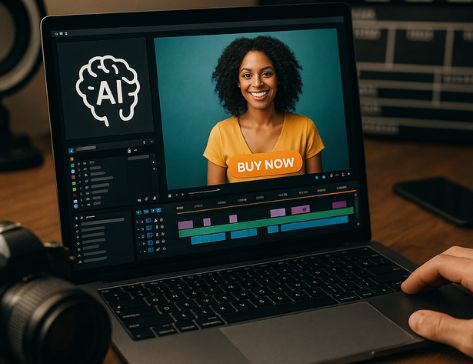
AI Video Tools for Ad Creation: The Essential Stack Every Marketer Should Use
AI video tools for ad creation are transforming how marketing teams concept, produce, and optimize video ads across platforms—cutting production time from weeks to days while improving creative quality and performance.
As budgets tighten and channels multiply, marketers need a way to rapidly test angles, formats, and creatives without sacrificing brand standards. The latest wave of tools—spanning scriptwriting, editing, voice, avatars, and automated optimization—means lean teams can ship more ads with higher precision. For a broader view of the surrounding landscape and complementary solutions, see this excellent AI marketing tools primer that helps you map your stack end-to-end.
Still, not all automation is created equal. The goal isn’t to press a magic “make ad” button; it’s to build a modular, repeatable workflow that blends AI speed with human judgment. In practice, that means treating each stage—research, scripting, storyboarding, production, editing, voice, post, and optimization—as a small, automatable system you can refine over time.
Creativity still wins, and the best-performing ads usually hinge on a strong narrative arc and emotional payoff. If you’re looking to sharpen that edge, this insightful guide on storytelling in video ads shows how emotion, structure, and rhythm can meaningfully lift performance.

Why AI video tools matter now
Video distribution has exploded—shorts, reels, in-stream placements, CTV, and programmatic video all demand unique cuts and hooks. Without AI, adapting concepts to each context is slow and expensive. With AI, teams can generate multiple on-brand variants, localize voiceovers, auto-create captions, and rapidly iterate hooks so each placement gets a fit-for-purpose version.
- Speed-to-test: Compress ideation → production → launch from 2–4 weeks to 2–4 days.
- Cost efficiency: Repurpose existing assets and synthesize missing elements (voice, b‑roll) cheaply.
- Performance headroom: Multivariate creative testing surfaces winning combinations sooner.
- Localization & accessibility: Auto-captioning, multi-language TTS, and on-screen text help global reach.
Must-have categories and practical use cases
1) Research and concepting
Use AI to analyze reviews, support chats, and competitor ads for pain points, desired outcomes, and language patterns. Turn those into angle hypotheses like “before/after,” “myth vs. fact,” or “POV demo.”
2) Script generation and beat outlines
Start with 3–5 beats: hook, problem, product reveal, proof, CTA. Ask AI to produce multiple versions per angle with options for 6s, 15s, and 30s cuts. Keep lines short and punchy so they pace well in editing.
3) Storyboarding and shot planning
Convert scripts into shot lists. For each beat, specify framing (wide/medium/close), movement (push/pull), subject action, and on-screen text. AI can draft alt boards for vertical vs. horizontal formats.
4) Generative visuals and b‑roll
Fill gaps with AI-generated b‑roll or stylized transitions. Use consistent style prompts, color palettes, and brand motifs to maintain coherence across variants.
5) Voiceover and synthetic presenters
Turn scripts into natural multi-language VO, and optionally pair with an on-brand avatar for explainer formats. Keep pacing brisk and add subtle breaths for realism.
6) Editing, assembly, and motion
Automate rough cuts from beat outlines; then refine transitions, pacing, and emphasis (zoom on key moments, speed ramps, kinetic type). Use auto-captioning with brand fonts.
7) Variants, dynamic creative, and compliance
Generate hooks, headline overlays, background tracks, and end cards in batches. Enforce brand safety with profanity filters, logo placement checks, and duration rules.
A step-by-step workflow to build a performance ad in one day
- Angle mining (1–2 hours): Cluster user quotes and reviews by benefit. Pick 2–3 angles that map to different objections or outcomes.
- Write three scripts (1 hour): Draft 15–25 second scripts per angle. Keep the hook under 3 seconds, include one proof element (stat, testimonial, demo), and end with a clear CTA.
- Storyboard beats (30 minutes): Convert scripts to 5–7 beats. Assign shot types and on-screen text. Flag any b‑roll gaps.
- Generate assets (1 hour): Synthesize VO in two voices (neutral and energetic), create missing b‑roll, pull logo and product shots from your library, and prep end cards. Align with the emotional cadence you want—humor, urgency, calm—because, as strong research on emotion in storytelling shows, feeling drives recall and conversion.
- Assemble a rough cut (1 hour): Drop beats on a timeline, align VO, add captions, and slot music. Keep the waveform visible and tighten edits to transients.
- Create three hook variants (30 minutes): Swap the first 3 seconds: a startling stat, a visual transformation, or a blunt problem callout.
- Localize (30 minutes): Auto-generate captions and VO in top locales. Adjust idioms and on-screen offers per region.
- QA and brand safety (20 minutes): Verify logo clear space, ensure legal copy is legible (>4% of vertical height on mobile), and check volume normalization.
- Export platform cuts (20 minutes): Render 9:16, 1:1, and 16:9. Name files with angle, hook, and date for clean analytics.
- Launch and tag (30 minutes): Upload with UTM-tagged CTAs, and document hypotheses in your experiment log.
Pro tips to scale creative testing without losing quality
- Front-load the hook: The first 2–3 seconds decide 70% of outcomes. Keep movement in frame and a clear visual change.
- Script for captions: Many users watch muted. Write lines that read well on-screen with 6–10 words per card.
- Use consistent style systems: Lock color, typography, lower thirds, and CTA treatments so variants look cohesive.
- Keep one variable per test: When learning, don’t change hook, music, and headline at the same time. Isolate.
- Exploit micro-variants: Change verb tense, reorder beats, or swap a reaction shot. Tiny edits often move metrics.
- Mind platform context: TikTok favors native, lo-fi energy; YouTube in-stream tolerates more polish; Reels needs fast visual rhythm.
- Legal and accessibility: Caption everything, avoid rapid strobe effects, and ensure on-screen text meets contrast ratios.
Quick QA checklist before you publish
- Messaging: Is the problem-solution arc obvious by second 5?
- Branding: Logo appears once in the first half and once in the end card.
- Sound: VO peaks under −1 dBTP; integrated loudness ~−14 LUFS for social.
- Captions: Accurate punctuation; no text colliding with UI chrome.
- Thumbnails: Text under 20% of frame; face and product visible.
- Tracking: UTMs validated; platform pixel firing in preview.
- Compliance: No prohibited claims; required disclaimers readable for 3+ seconds.
Conclusion: Build a modular system, not one-off miracles
AI won’t replace your taste or strategy, but it will radically reduce the time between ideas and live tests. Start by installing the “operating system” above—angles → scripts → beats → assembly → variants—and then layer on automation where it removes friction. As you expand channels, remember that context and placement matter; for competitive insights into video placements and what’s resonating in-stream right now, tools like Anstrex Instream can sharpen your targeting and concept selection.
Ship small, learn fast, and roll your wins into a creative library that compounds. The teams that pair disciplined workflows with these AI accelerators will consistently out-iterate their competitors.


